Once upon a time, there was a little mouse who was super hungry! He decided to go to a garden to find something yummy to eat.
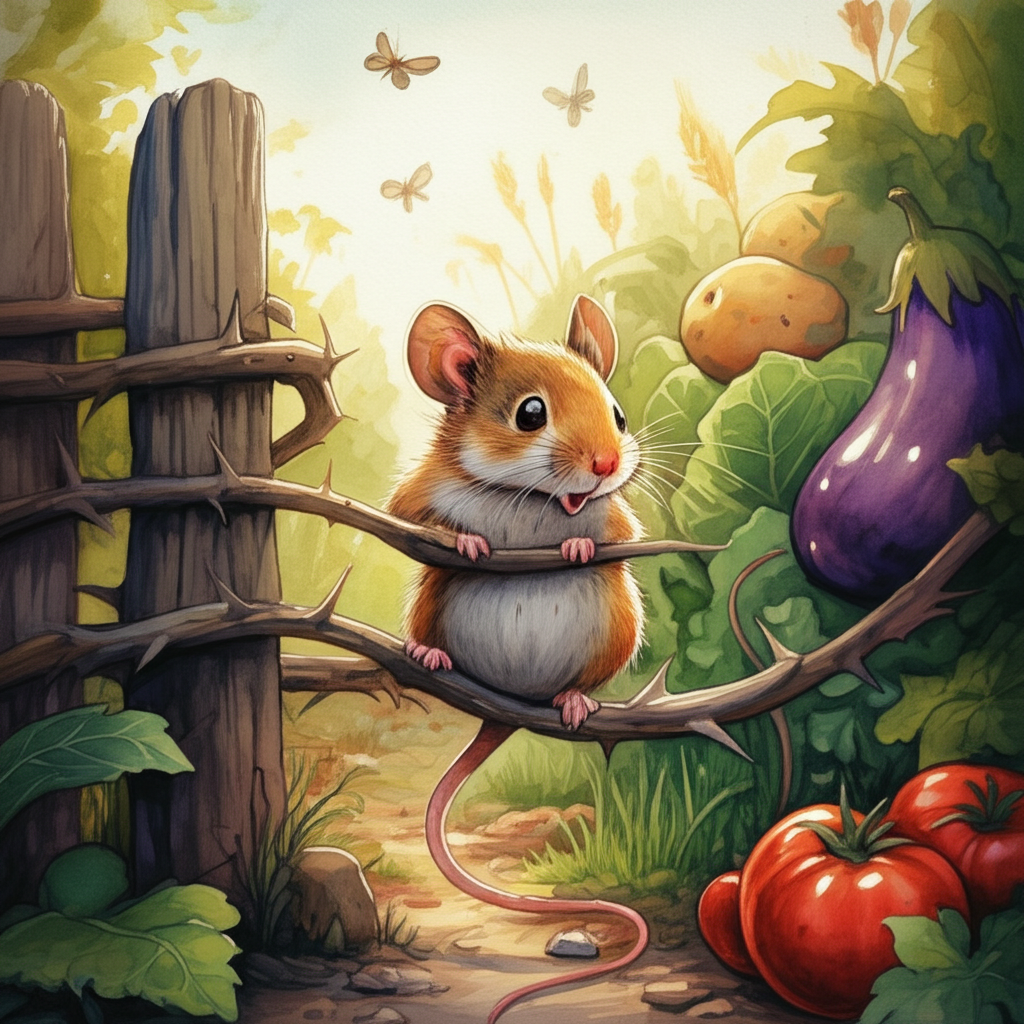
In the garden, there were lots of grains, fruits, cabbages, and other yummy vegetables growing. But the people who owned the garden had put up a prickly fence all around it, made of thorny bushes, to keep animals out. The little mouse squeezed through the thorny fence, but ouch! Big thorns poked his tail, and he started to cry.
He wiggled back out of the garden through the fence and, on his way home, he bumped into a barber.
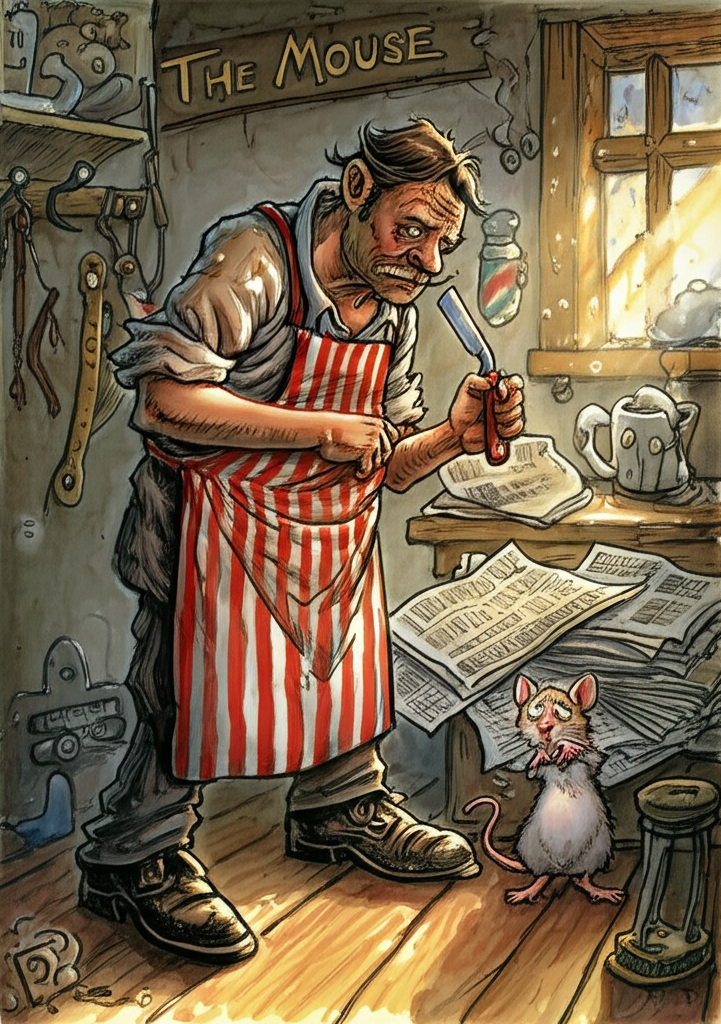
“Please, Mr. Barber, can you take these thorns out of my tail?” the mouse asked.
“Hmm, I can’t take them out without cutting off your tail with my razor,” said the barber.
“Okay, okay! Just cut off my tail!” said the mouse.
So, the barber cut off the mouse’s tail. The mouse was so mad! He grabbed the razor and zoomed away with it! The poor barber was very sad and started to cry because he didn’t have any money to buy a new one.
The mouse ran and ran until he came to a new place. In this place, they didn’t have any knives or special tools to cut the grass. The mouse saw a man pulling the grass out of the ground with his bare hands.
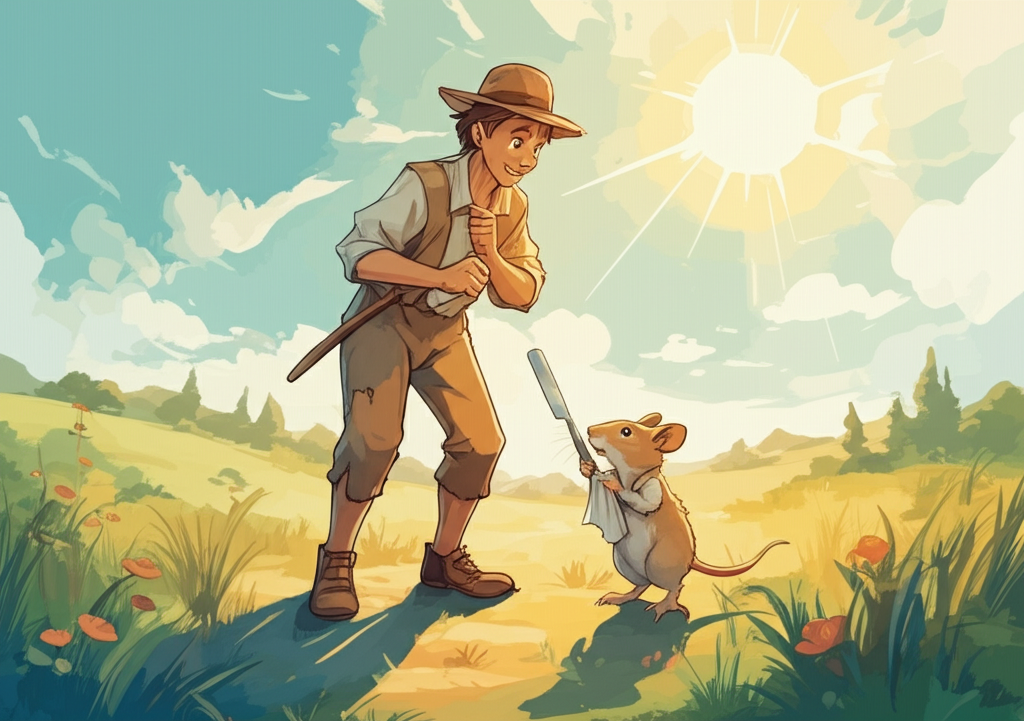
“You’ll hurt your hands!” the mouse said.
“But there are no knives here,” said the man. “So, I have to pull the grass up this way.”
“Here, you can use my razor!” said the mouse.
“But what if it breaks? I couldn’t buy you a new one,” said the man.
“Don’t worry if it breaks! I’m giving it to you as a present!” said the mouse.
So, the man took the razor and started cutting the grass. But as he was cutting, SNAP! The razor broke!
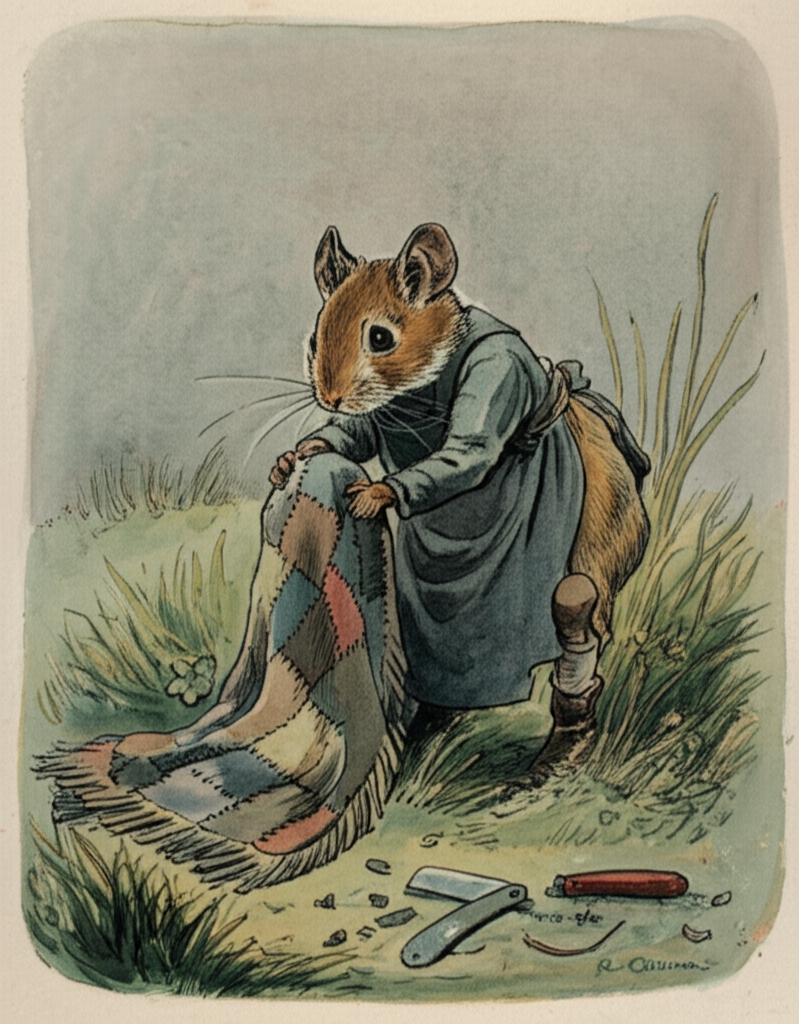
“Oh no! Why did you break my razor?!” cried the mouse.
“Didn’t I tell you it might break?” answered the man.
The mouse was so angry! He snatched up the man’s blanket and ran off with it. The grass-cutter started to cry. “Oh no! What will I do? The mouse took my blanket, and I don’t have money to buy a new one!” He went home feeling very sad.
Meanwhile, the mouse ran and ran until he came to another place. He saw a person selling grains, and he was chopping up sugar canes. But he didn’t have a blanket or cloth to put the canes on, so he chopped them on the ground, and they got all dirty.
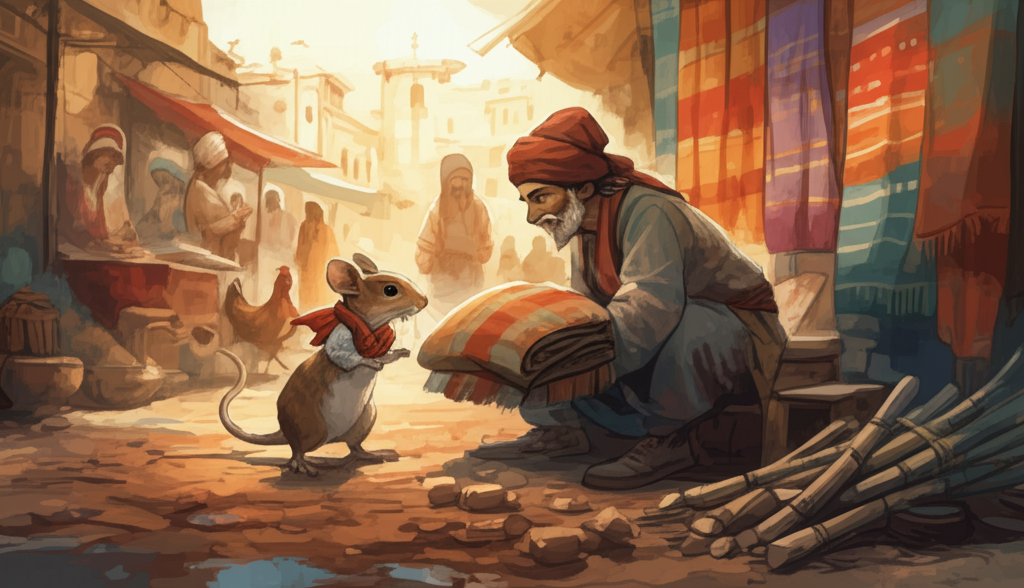
“Why are you chopping your canes on the ground?” said the mouse. “They’re getting dirty!”
“What can I do?” answered the man. “I don’t have any money to buy a blanket to chop them on.”
“Well, why don’t you use mine?” said the mouse.
“If I used yours, it would get cut, and I don’t have money to buy you a new one,” said the grain seller.
“That’s okay! I don’t need another one!” said the mouse.
So, the man took the blanket and chopped the sugar canes. Of course, he cut holes in the blanket! When he was finished, he gave it back to the mouse.
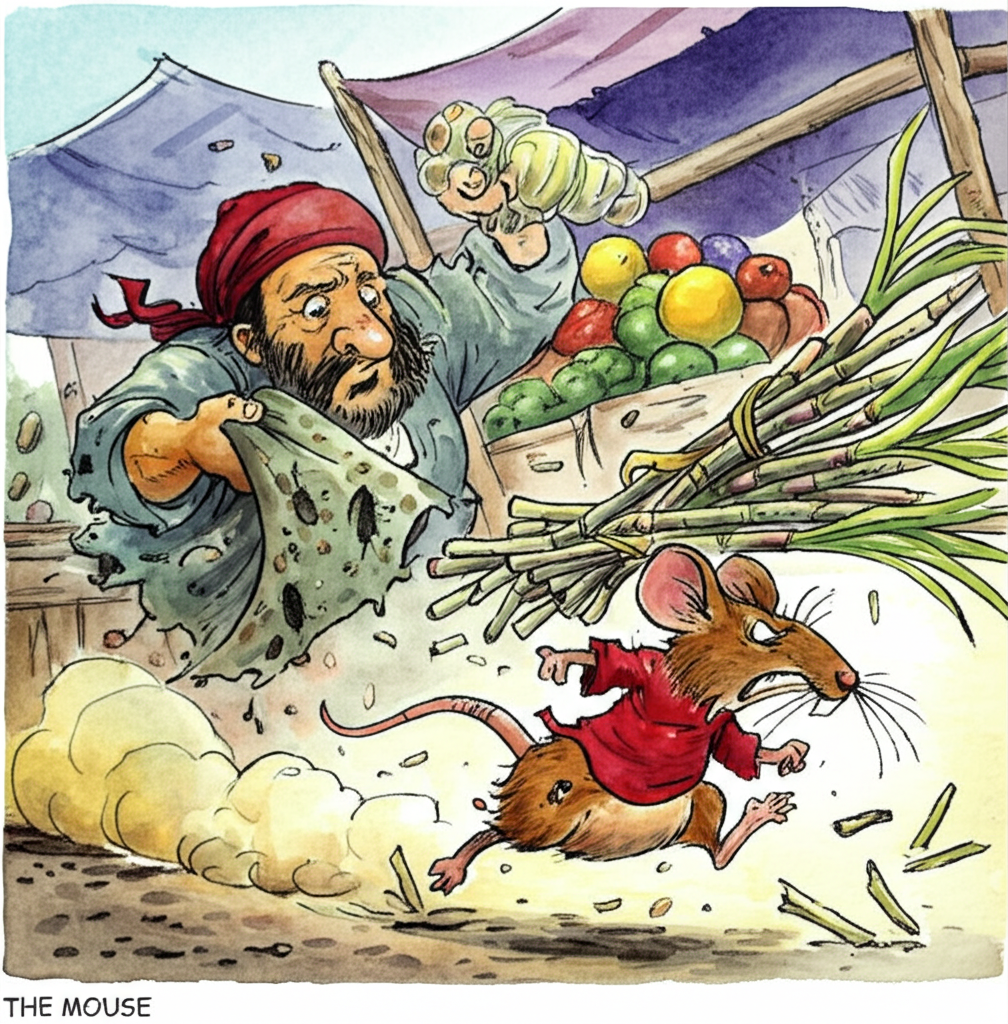
When the mouse saw all the holes in his blanket, he was super angry! He grabbed all the sugar canes and ran away as fast as he could. The grain seller started to cry. “Oh no! What will I do? I don’t have any more sugar canes!” He went home feeling very sad.
Then the mouse ran and ran until he came to another place. He stopped at a candy shop. Now, in this place, they didn’t have any salt or sugar! The candy maker made his candies with flour and butter, but without sugar or salt, so they tasted yucky!
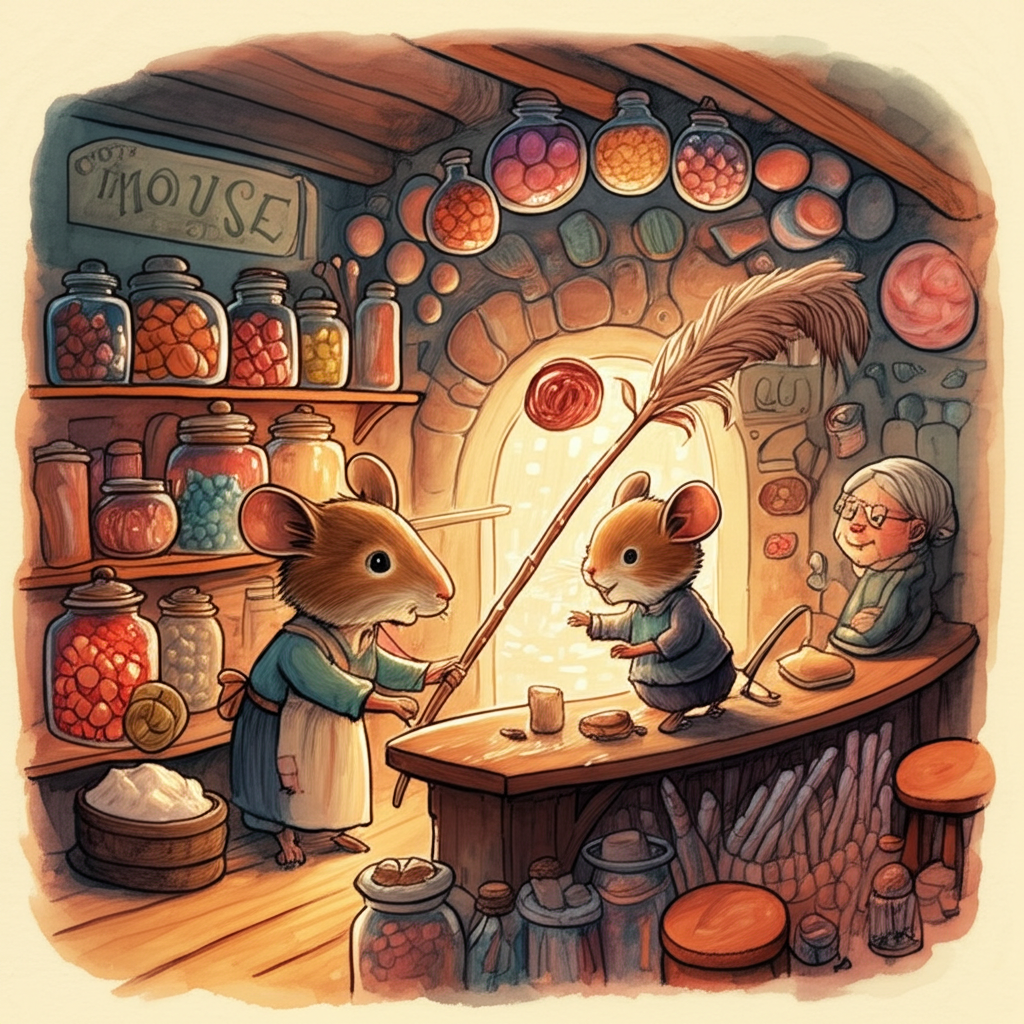
“Will you give me some candy for a tiny bit of money?” the mouse asked the candy maker. “Yes,” answered the man, and he gave him one. The mouse tasted it and thought it was really yucky!
“Ew! There’s no sugar in it!” exclaimed the mouse.
“No,” said the man. “We don’t have any sugar in this place. The few sugar canes we have are so expensive that poor people like me can’t buy them.”
“Then take my sugar canes!” cried the mouse.
“No,” said the man. “I don’t have any money to pay you for them! And I would use them all to make candies!”
“Just take them!” said the mouse. “I’m giving them to you!”
The candy maker took them and started making all kinds of candies. He used all the sugar canes!
“Why did you use all my sugar canes?!” cried the mouse.
“Didn’t I tell you I would?” said the man.
“You’re a thief!” cried the mouse, and he knocked the candy maker down, grabbed all the candies, and ran off with them!
“Oh no! What will I do now?” cried the candy maker. “I don’t have any money to buy flour and butter to make more candies! And if I argue with the mouse, he might hurt me!”
Meanwhile, the mouse ran and ran until he came to a place where the king had lots and lots of cows - hundreds of them! The mouse stopped where the cows were eating grass. Now, the cow herders were very poor. They couldn’t buy fresh bread every day, and sometimes they had to eat bread that was days and days old! When the mouse arrived, the cowherds were eating their old, hard, and moldy bread.
“Why are you eating that old bread?” said the mouse.
“Because we don’t have money to buy any other bread,” answered the cowherds.
“Look at all these candies!” said the mouse. “Take them and eat them instead of that old bread!”
“But if we eat them, we have to pay you for them, and we don’t have any money!” said the cowherds.
“Oh, don’t worry about the money!” said the mouse.
So, the cowherds took the candies and ate them all up! The mouse was furious! He grabbed a stick and stuck it in the ground. Then, he ran and got some ropes and tied the cowherds to the stick, hand and foot. Then he took all the cows and ran away with them!
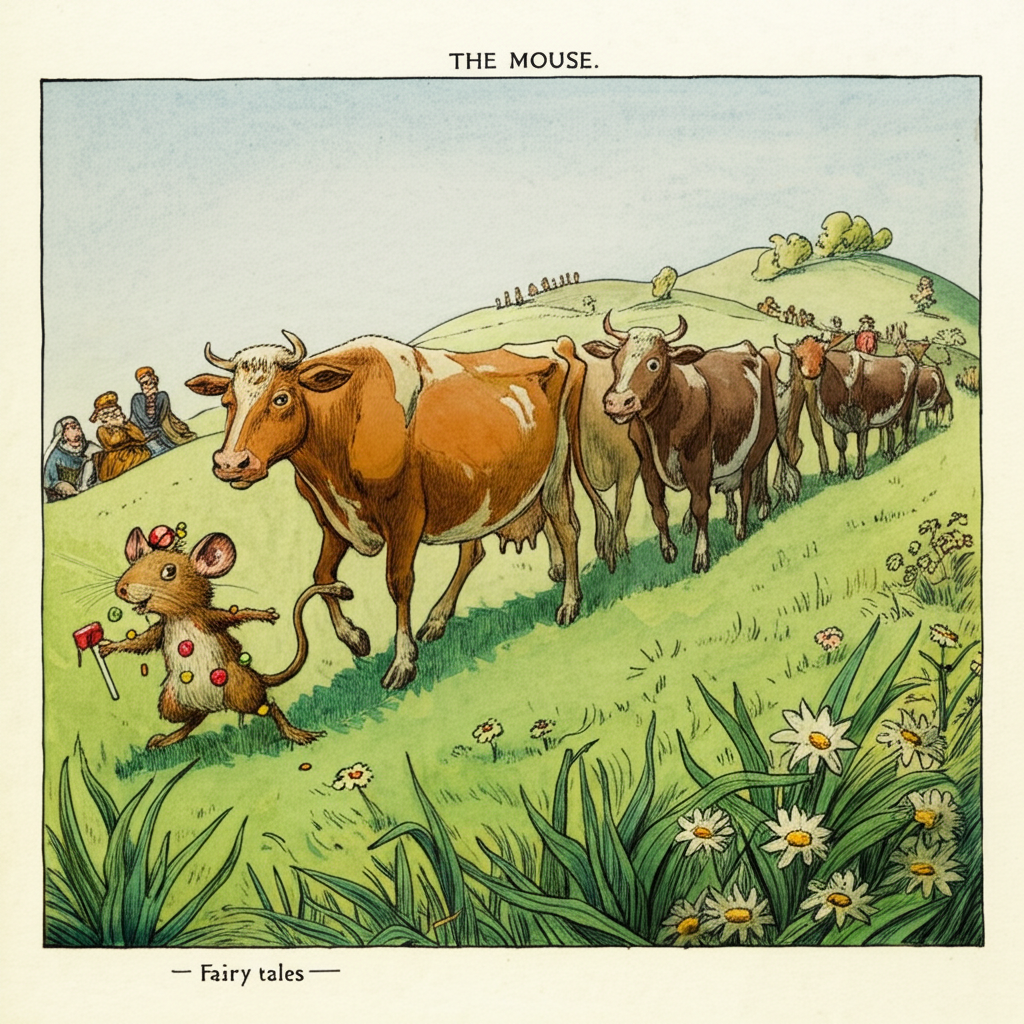
He ran and ran until he got to a place where there were no chickens, no cows, no buffaloes, no meat of any kind! The people there didn’t even know what milk and meat were! The day the mouse arrived was the day the king’s daughter was getting married, and lots of people were getting together. The king’s cooks were cooking, but they didn’t have any meat or butter.
“Why are all these people here?” said the mouse.
“Today is our king’s daughter’s wedding day, and we’re cooking the dinner!” answered the cooks.
“But you don’t have any meat!” said the mouse.
“No,” said the cooks. “There’s no meat of any kind in our place.”
“Take my cows!” said the mouse.
“No,” said the cooks. “Our king couldn’t pay for them. He’s too poor!” (He was just a little king).
“It doesn’t matter!” said the mouse. “I don’t want any money!”
So, the cooks took the cows and the sheep and killed them. They cooked their meat in different ways. They made yummy rice dishes and sauces. They roasted some and boiled some and gave it to the people to eat. In this way, they used up all the cows.
“Why did you use up all my cows?!” cried the mouse.
“Didn’t we tell you we would use them all?” said the cooks.
“Give me my cows back!” said the mouse.
“We can’t. The people have eaten them all up!” said the cooks.
The mouse was super angry. He ran off to the groom, who was walking near the kitchen, thinking to himself, “Now I’ll go get my bride!”
“Give me the money for my cows!” cried the mouse to him. “Your people have eaten them all up, and your cooks won’t pay me, so you have to!”
“What do I have to do with your cows?” said the groom. “I won’t pay you for them!”
“Then if you won’t pay me, your wife’s father has to!” said the mouse.
“Oh, he’s too poor to pay for your cows,” said the groom, “and I won’t!”
“Then if I don’t get paid, I’ll take away your bride!” said the mouse. He ran off and carried away the bride!
The king was very angry about this, but the mouse ran and ran with his wife (that’s what he called the king’s daughter) until he came to another place.
Now, the day he arrived, there were going to be fun shows to make the king happy! Some jugglers and rope-walkers were going to perform.
“Take my wife and let her walk on the rope. She’s young, and your wives are old,” said the mouse to the rope-walkers.
“No,” they answered. “She doesn’t know how to walk on a rope and carry a wooden plate on her head at the same time. She would fall and hurt herself!”
“But you have to take my wife!” said the mouse. “She won’t fall! She’s young, and your wives are old. You really have to take her!”
So, the rope-walkers took her, even though they didn’t want to. When she started walking on the rope with the wooden plate on her head, she fell and was badly hurt!

“Oh no! Why did you hurt my wife?!” cried the mouse.
“Didn’t we tell you she would fall and hurt herself?” answered the rope-walkers.
The mouse grabbed all the jugglers’ and rope-walkers’ wives and the things they used in their shows and ran off with them. Then, the rope-walkers and jugglers started to cry and said, “Oh no! What will we do? Our wives and our things are all gone!”
Meanwhile, the mouse ran and ran until he came to another place. He found a house to live in. He ate a lot and grew so fat that he couldn’t get through the door of his house!
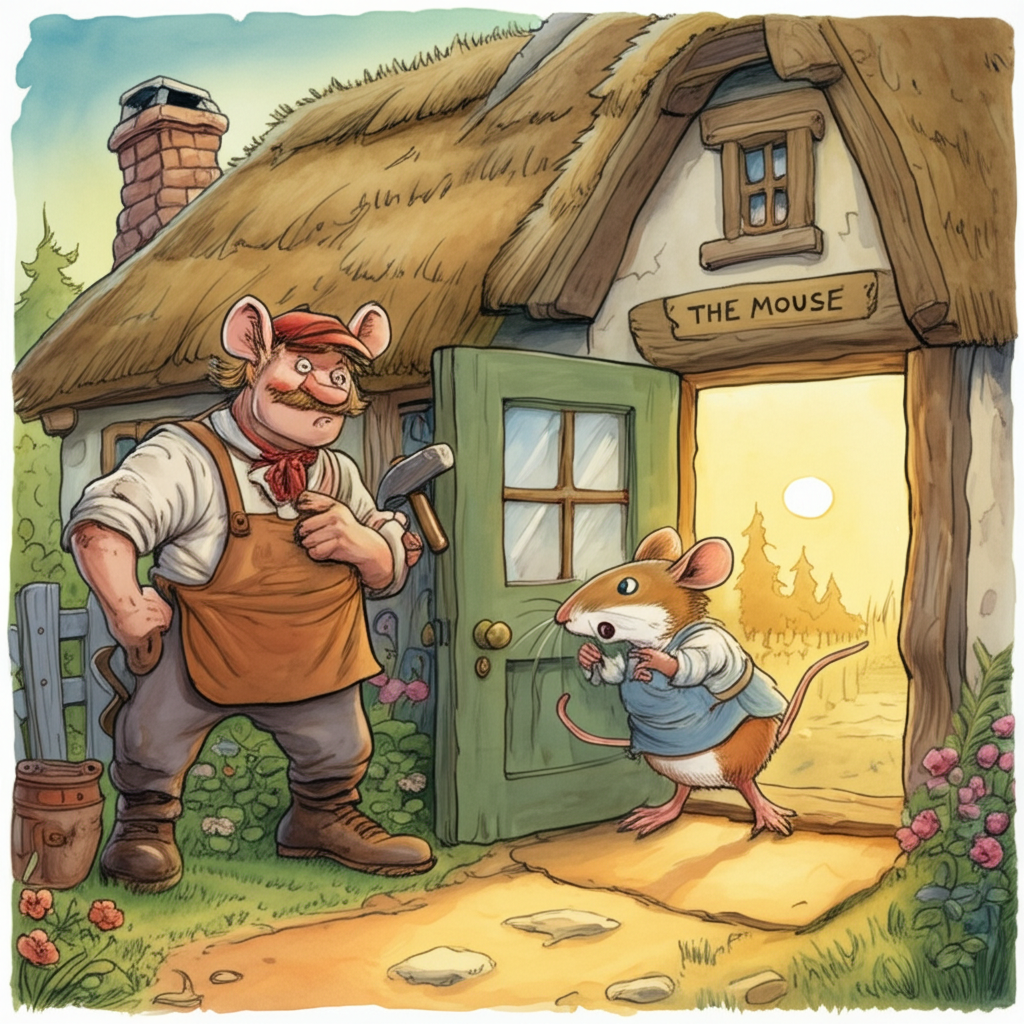
“Send for someone who builds things from wood,” he said to the rope-walkers’ and jugglers’ wives. “Tell him to cut off some of my fat. Then I’ll be able to get into my house!”
The women sent for a carpenter, and when he came, the mouse said to him, “Cut off some of my fat, then I’ll be able to go into my house.”
“If I do that,” said the carpenter, “you might die.”
“No, I won’t!” said the mouse. “Just do what I tell you.”
So, the carpenter took his knife and cut off some of the mouse’s fat.
“Oh, dear! Oh, dear!” cried the mouse. “That really hurts! What can I do to make it stop hurting?”
“You should go to a place where a special kind of grain grows, and rub the grain on your hurt spots. Then they’ll feel better,” said the carpenter.
So, the mouse ran off to the place the carpenter had told him about, and rubbed his hurt spots with the grain. But this hurt him so much that he fell down and was no more.
The rope-dancers’ and jugglers’ wives went home to their husbands with all the things the mouse had carried away, and they all lived happily ever after!